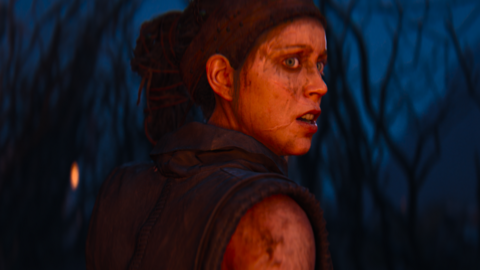
It shouldn’t come as a surprise to me anymore that this generation of consoles are powerful machines and studios can just more easily disguise their witchcraft to create cool visual effects, but I’m still routinely dumbfounded. The latest example is Senua’s Saga: Hellblade II, in which Ninja Theory has managed this incredible visual trickery with rocks.
As you’re walking through Hellblade II’s Iceland, you may notice some outcroppings that suspiciously look like faces. These are examples of protagonist Senua’s psychosis tricking her mind into recognizing a pattern that’s not actually there. If you choose to focus on these optical illusions, they’ll shift and reveal secret tunnels for Senua to maneuver through. When I played Hellblade II on Xbox Series X, the transformation was seamless, mimicking (albeit on a grander scale) what it’s like for your eyes to play tricks on you in real life. It’s incredible.
“A lot of it came from speaking with (Bernard Wolfe Professor of Health Neuroscience) Paul Fletcher and the people with lived experience (of psychosis),” Ninja Theory VFX director Mark Slater Tunstill told me. “That’s kind of a privilege for us; for those people to be open enough to talk about their experiences and what they’ve gone through, what they are going through. And listening to that, there’s a lot you can take from it, but you get some sort of key themes and then you go, ‘Actually, if that was happening to Senua, how would she perceive the world?'”
Fletcher has been a key collaborator on both Hellblade games, utilizing his expertise to aid Ninja Theory in its depiction of psychosis. In Hellblade II, that extends to gameplay features tied to the environment, such as optical illusions. Visual tricks like this aren’t unheard of in video games, but Hellblade II certainly seems to push the envelope in that regard and achieve a level of seamless transformation that ups the immersion of the experience. It certainly helps that Ninja Theory traveled to Iceland to map out the environment and pull reality into the game. The game looks real because a great deal of it is–a strategy the studio used to bring character to Hellblade II’s world. Iceland does have rocks that look like faces, feeding the legends of trolls who turned to stone after being caught out in daylight.
“The whole reason why we went out to Iceland was to capture it, to be as faithful as possible so people don’t question it,” Ninja Theory environment art director Dan Atwell told me. “So you’ve got that kind of sedimentary layer of environmental storytelling on it, that’s really important to us. And it is the same for the other (details), even down to the voice recordings and the character costumes and all that kind of stuff. It’s all very much, we’ve got the same ethos and mentality when it comes to that kind of stuff.”
“I think the other advantage we have is Senua’s character itself,” Tunstill added. “So the whole game is obviously told through her eyes. So the way she perceives that environment isn’t necessarily the exact ground truth. Depending on her emotional state at that point, she’s obviously imprinting other things onto it, and a lot of the visual effects side of things come from that. So it’s taking the real grounded, real world stuff and breaking that open because that’s how Senua would be at that point in the story.”
You’ll be able to explore Iceland as Senua soon enough. Senua’s Saga: Hellblade II is scheduled to launch for Xbox Series X|S and PC on May 21, releasing on Xbox Game Pass on the same day.
